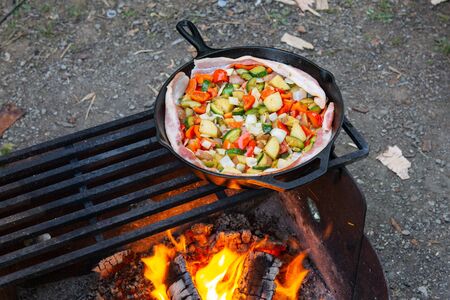Introduction to Quick Veg One-Pot Pulao
Pulao, a cherished staple in Indian households, has long been celebrated for its comforting flavors and wholesome simplicity. This beloved rice dish is often enjoyed across the country, from bustling metros like Mumbai and Delhi to serene towns in Kerala and Assam. Traditionally prepared with aromatic basmati rice, vibrant vegetables, and subtle spices, pulao brings families together with its homey essence. In today’s fast-paced world, a quick veg one-pot pulao not only satisfies taste buds but also aligns with eco-conscious values. By using minimal ingredients and preparing everything in a single vessel, this recipe reduces energy use, limits food waste, and minimizes water consumption—making it an environmentally friendly choice for mindful kitchens. Whether you’re a busy professional in Bengaluru or a student living in a Pune hostel, this easy recipe promises both convenience and sustainability while keeping the spirit of Indian comfort food alive.
2. Essential Ingredients: Local and Seasonal Choices
For an authentic and eco-friendly veg pulao, it’s best to use ingredients that are easily available in your local sabzi mandi or market. Choosing desi (local) vegetables not only supports farmers but also reduces carbon footprint, as these veggies do not travel long distances. Opt for what is fresh and in season—this ensures better taste and nutrition. Below is a table listing common Indian seasonal vegetables and sustainable grains you can mix and match for your one-pot pulao:
Season |
Vegetables |
Sustainable Grains |
|---|---|---|
Summer |
Lauki (bottle gourd), Bhindi (okra), Beans, Carrot | Brown Rice, Millets (Bajra, Jowar) |
Monsoon |
Tinda, Turai (ridge gourd), Capsicum, Green peas | Red Rice, Little Millet |
Winter |
Cauliflower, Carrot, Matar (peas), Spinach | Basmati Rice, Foxtail Millet |
By sticking to minimal yet seasonal ingredients like those above, you make sure your pulao is light on the planet and rich in desi flavours. Remember, there is no need for imported or exotic produce; India’s own seasonal bounty makes every meal special and sustainable.

3. Step-by-Step Simple Cooking Method
Making veg pulao the easy, eco-friendly way is all about using one vessel and minimal resources. Here’s how you can prepare a wholesome meal with a straightforward process that saves time, water, and energy—perfect for busy Indian households or anyone embracing a minimal lifestyle.
Gather Your Ingredients
Start by assembling your basic ingredients: basmati rice, mixed seasonal veggies like carrots, beans, peas, a few whole spices (jeera, bay leaf, cloves), salt, turmeric, and a dash of oil or ghee. No need for fancy items—stick to what’s easily available in your local market or kitchen shelf.
Preparation Made Easy
Rinse the rice thoroughly to remove excess starch. Chop the vegetables into bite-sized pieces to ensure even cooking. There’s no need for extra bowls or complicated prep—keep it simple and fuss-free.
One-Pot Cooking Steps
1. Heat oil or ghee in a thick-bottomed kadhai or pressure cooker.
2. Add jeera and whole spices; let them splutter for aroma.
3. Toss in chopped veggies and sauté for 2-3 minutes.
4. Add rinsed rice and stir gently to mix everything.
5. Pour in double the amount of water as rice (for example, 1 cup rice = 2 cups water).
6. Season with salt and turmeric.
7. Cover with a lid and cook on low flame till the rice absorbs all water (about 15 minutes) or give one whistle if using a pressure cooker.
This method minimises dishwashing and reduces energy consumption—a true reflection of Indian jugaad and sustainable living practices.
Your quick veg pulao is ready to serve hot, straight from the same pot!
4. Tips for Reducing Kitchen Waste
When preparing a Quick Veg One-Pot Pulao, embracing Indian zero-waste kitchen traditions not only honours the environment but also brings out the best in our home-cooked meals. Here are some creative and practical ways to minimise waste by using leftover ingredients and peels, making your cooking truly sustainable.
Creative Uses of Leftover Ingredients
| Leftover Ingredient | Zero-Waste Tip (Indian Style) |
|---|---|
| Vegetable Peels (Potato, Carrot, Bottle Gourd) | Sun-dry and fry for crunchy snacks, or add to homemade sabzi masalas. |
| Coriander Stems | Grind into chutneys or add to pulao tempering for extra flavour. |
| Rice Water (from rinsing rice) | Use for kneading dough (roti/chapati) or watering plants as a natural fertiliser. |
| Lemon Peels | Add to pickles, or dry and powder them for spice blends (masalas). |
| Leftover Cooked Veggies | Mash and use as stuffing for parathas or add to dals/curries. |
Embracing Minimalism in Everyday Cooking
The essence of minimal-ingredient cooking is to make each item count. Whenever possible, choose locally-sourced, seasonal produce. This reduces packaging waste and supports Indian farmers. Remember that “kitchen ka kachra” can become tomorrow’s flavourful side dish with a bit of creativity!
Zero-Waste Practices from Indian Households
- Composting: Collect organic scraps and compost them for your home garden, just like many Indian families do with their daily ‘sabzi’ remains.
- Dried Peels: Use sun-dried peels in dals or grind them into powders for health tonics, a practice followed in Ayurveda.
- No Plastic: Store leftovers in steel dabbas instead of plastic containers—a simple swap rooted in Indian tradition.
Sustainable Cooking Mindset
By integrating these habits into your Quick Veg One-Pot Pulao routine, you’ll find joy in every part of the vegetable and grain you use. Reducing waste is not just good for the planet—it’s a return to mindful, resourceful Indian cooking that respects both taste and tradition.
5. Serving Ideas with a Minimalist Touch
When it comes to enjoying your Quick Veg One-Pot Pulao, simplicity is key. By sticking to minimalist accompaniments, you not only keep your meal eco-friendly but also let the natural flavours of the pulao shine. In many Indian homes, a humble bowl of homemade curd (dahi) is the go-to side for pulao. Making curd at home is both sustainable and economical, and it adds a cooling element that complements the spices in the rice beautifully. If you want a bit more tang, reach for achar—whether it’s mango, lime, or mixed vegetable pickle—using whatever you already have in your pantry. These sides require minimal effort and resources while keeping your meal wholesome and satisfying. For an extra touch, garnish your pulao with fresh coriander leaves or a squeeze of lime; both are easy to grow at home or source locally. Remember, less is more: serving your pulao with mindful portions of these simple sides not only honours traditional Indian dining but also supports a minimalist and environmentally-conscious lifestyle.
6. Conclusion: Mindful Eating Indian Way
As we wrap up our journey with this quick veg one-pot pulao recipe, lets reflect on the deeper value of mindful eating, rooted in Indian tradition. By choosing minimal ingredients and a simple cooking process, we honour not just our time and resources, but also the environment. Embracing minimalism in the kitchen reduces waste, conserves energy, and lets the natural flavours of local veggies and spices shine. This is sustainability the Indian way—celebrating every grain of rice and every vegetable for its true worth. As you enjoy your wholesome bowl of pulao, remember that each meal is an opportunity to nurture both your body and Mother Earth. Lets continue cherishing our rich culinary heritage while making choices that support a greener, simpler lifestyle. Every step towards minimalism is a celebration of India’s timeless wisdom and care for the world around us.


